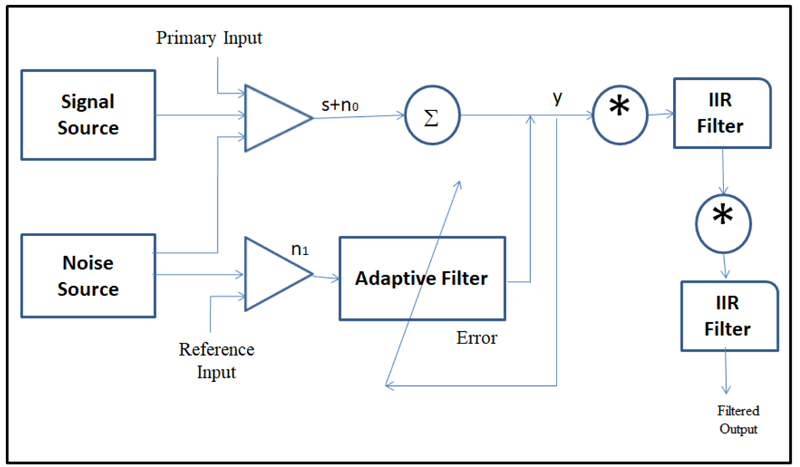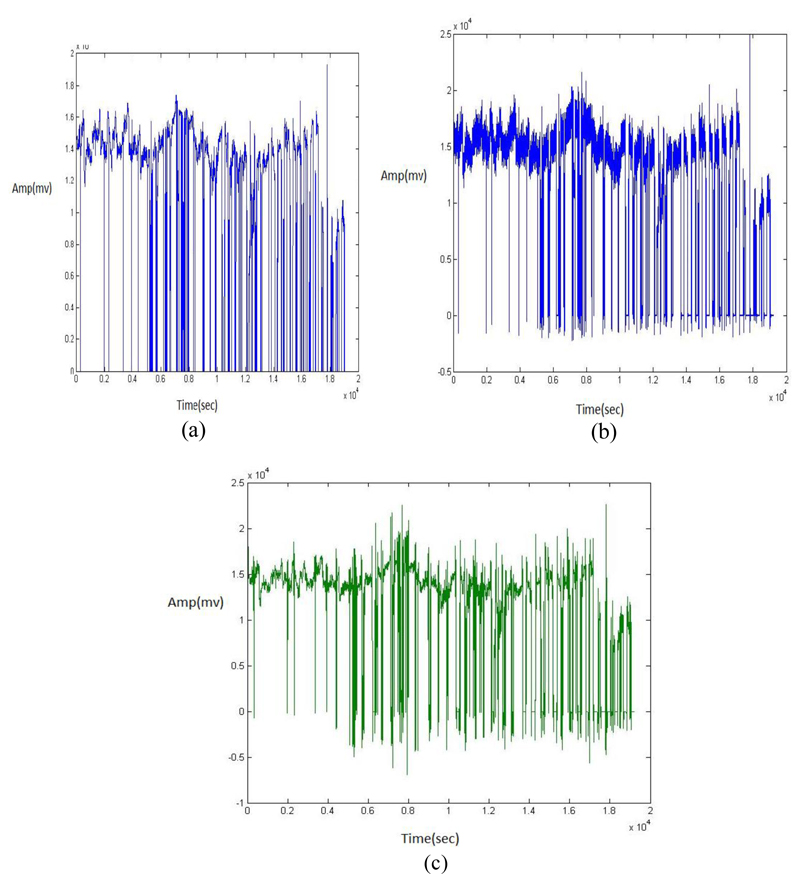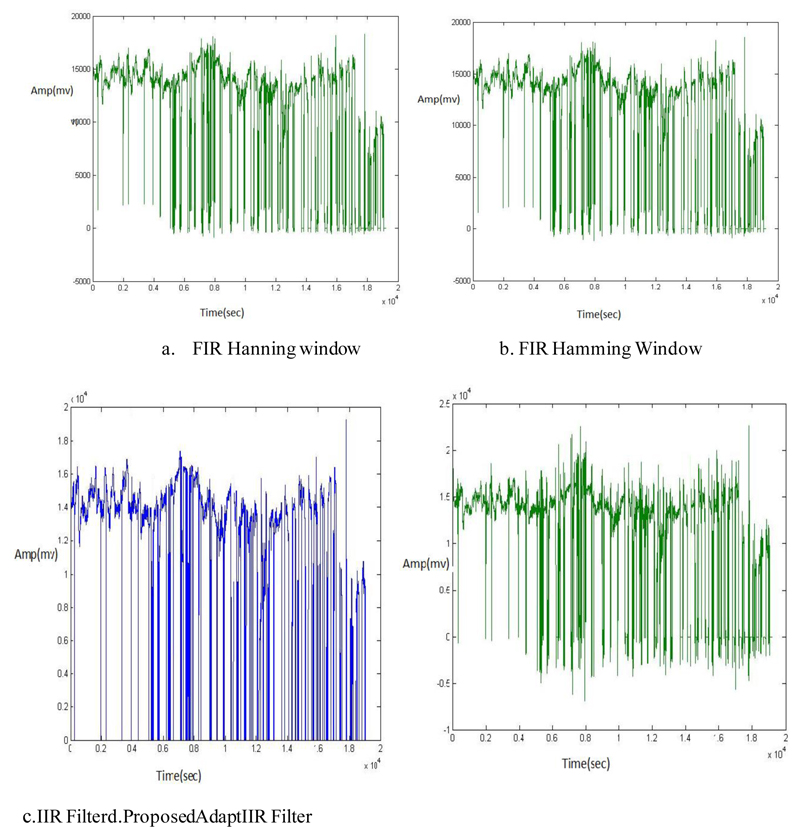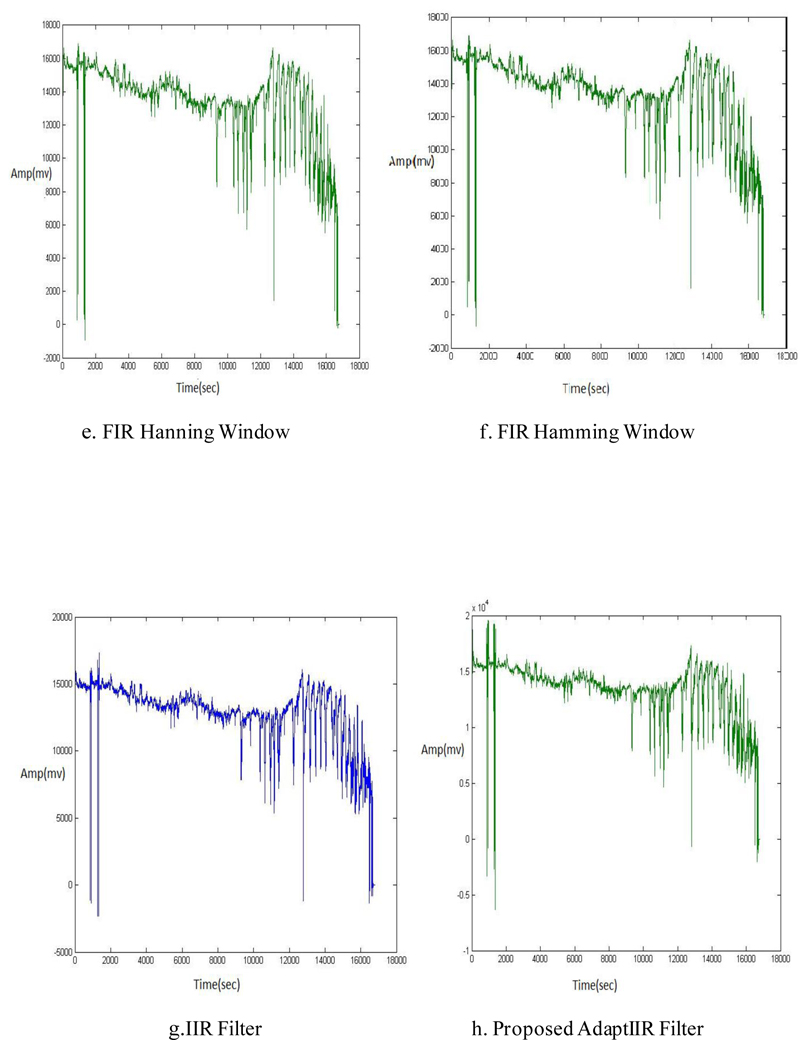Novel Digital Filter Design for Noise Removal in Fetal Ecg Signals
Abstract
Background:
In Maternal and Fetal Health care research, it is necessary to analyse both Maternal Electrocardiogram (ECG) and Fetal ECG(FECG) for analysing the health status of the mother and fetus. Noises are nothing but the presence of interferences due to the powerline, motion artifacts, electromyogram and baseline wander during ECG measurement. In this scenario, the cardiotocography (CTG) signal plays a vital role in the measurement of FECG, which includes Fetal Heart Rate (FHR) and Uterine Contractions (UC). In the FECG signal, it is necessary to filter the noises present to have an accurate classification of the fetus condition. In recent literatures, Infinite Impulse Response (IIR), Finite Impulse Response (FIR) and Adaptive filters are predominantly used for noise removal in FECG signals. Still now, achieving a high Signal-to-Noise Ratio (SNR) is a major challenge in noise removal in biomedical signal processing. Motivated by the above-said issues, in this work, a novel filter design named AdaptIIR Filter is proposed to improve the SNR value.
Methods:
In the proposed design, an adaptive filter is convolved with the IIR filter; the resultant is again convolved with the Chebyshev filter to improve the filtering response of the system. The system performance has been evaluated based on the signal-to-noise ratio and power of the FECG signal.
Results:
The experimental results have also been compared with the state-of-the-art filters, and it is observed that the proposed filter design achieves high SNR and signal power of 39.92dB and -100dB, respectively.
Conclusion:
Filtering operation plays a very important role in the noise analysis of biological signals for better accuracy. In the order of 5, the filter has shown to have the best result in terms of SNR and average power of the signal.
1. INTRODUCTION
World Health Organization(WHO) [1] showed in their statistics that there had been an increase in cardiac problems, especially in the fetus, for the last two decades. In biomedical research, it is needed research in cardiovascular issues. In a normal scenario, an electrocardiogram (ECG) is the non-invasive measurement method in the screening of heart diseases. ECG is used to determine the patients’ heart rate. A traditional ECG system attached to measure electrical signals. In CTG, both fetal Heart rate and uterine contractions are measured. The fetal heart rate derived from a fetal electrocardiogram (FECG) is interrupted by various types of noises [1].
During the measurement, contact between the electrodes and the skin of the human body disturbs the quality of the obtained ECG signal. The ECG signal has a frequency range of 0.5 to 100 hertz. ECG signals are corrupted due to various kinds of artefacts. As the equipment runs on alternating current (AC), the power grid is another source of noise in the ECG signals. The noises affecting the ECG signal are: 1. power line interference, 2. electrode contact noise, 3. motion artefacts, and 4. muscle contraction. 5. Baseline sway 6. Instrumentation noise is generated by electronic devices. In the presence of noise, ECG analysis leads to wrong diagnosis results. Also, in biomedical signal processing, it is necessary to eliminate various types of interference. In order to reduce and eradicate noise, digital and analogue filters are used in biomedical signal processing. But there is a non-linear phase shift during the use of analogue for noise removal. Digital filters are more accurate and precise than analogue filters. The linear time-invariant properties of filter systems are explored in digital filters. Digital filters are of two kinds: 1. FIR, 2. IIR. The resistor (R), inductor (L), and capacitor (C) are the basic components in the analogue filters and have stable parameters. The design of digital filters is complex as the design parameters can be changed, and it is based on the computing power of the central processing unit (CPU). So, it is better to have an efficient filter design. Therefore, the choice of filter design method plays an essential role in signal quality [2, 3].
2. RELATED WORKS
A few papers discuss the analogue and digital filters used in biomedical signal processing. Various filter algorithms are available for the removal of noise in ECG signals. They are described below.
Choudhary et al. [1], proposed a filter with the help of an FDA tool to filter the power line interference in ECG signals. A design and simulation of digital techniques like FIR filter, IIR filter, and Kaiser Window are proposed for the removal of power line interference (PLI) noise. The author’s experiment results showed better results in terms of signal-to-noise ratio, which indicated better removal of power line interference in the ECG signal. Rahmilla et al. [2] proposed an IIR notch filter to reject 50 Hz power line noise. The pole placement method is used with three kinds of band stop cut-off frequencies to determine the necessary filter coefficients. With the help of filter coefficients, the Arduino DUE is used for coding the program and proposed to reject power line noise with an average square of error value of 0.225 and 0.2831 on (49-51) Hz and (48-52)Hz filter designs.
Bui et al. [3] proposed an algorithm based on the IIR and FIR filters and validated the results with signal-to-noise ratio and signal amplitude. The results are interpreted under different sampling frequencies and then evaluated with IIR and FIR filters. The proposed algorithm is validated in the MIT/BIH database at 360 Hz sampling frequency with 11-bit resolution. The authors evaluated the proposed algorithm in real-time with a sampling frequency of 100 Hz to 2133 Hz. The results showed that a symmetric FIR filter is more suitable than an IIR filter for noise removal. Ondracek [4] used different filters like FIR and IIR filters, adaptive filters, and median filters for filtering operations. These filters are used for the suppression of piezoelectric line fluctuations, suppression of powerline noise, and suppression of mother ECG signal influence on foetal ECG signal noise. The parameters such as signal-to-noise ratio and power spectral density are used for the evaluation of the filter.
Kumar et al. [5] in their work used FIR and IIR filters to remove the unwanted noise present in the signal. On the noisy ECG signals, FIR filters like Rectangular, Hann, Blackman, Hamming, and Kaiser Window techniques are applied. Similarly, IIR filters like Butterworth, Chebyshev I, Chebyshev II, and elliptic filters are also used to reduce artefacts in ECG signals. The results are estimated based on the order of the filter. For FIR filters, the order is considered as 56, 300, 450, and 600 and for IIR filters, 1, 2, and 3. The signals taken from the MIT-BIH database containing both the normal and abnormal waveforms are used for evaluation. The work is implemented in the MATLAB FDA Tool. Evaluation parameters such as power spectrum density, signal-to-noise ratio (SNR), and mean square error (MSE), are estimated for both the noisy input signal and the filtered signal. The Digital FIR filter with Kaiser Window of order 56 shows better results when compared with other windowing techniques.
Sharon et al. [6] in their work added additive white Gaussian noise to the ECG signal. Transforms like DFT, DCT, FWHT, and DWT are applied to the noisy ECG signal. After that, a filtering operation is performed on the coefficients of various transforms. Parameters like time consumption and order of the filter performance are evaluated for different types of filters. Chandrakar et al. [7] described the filtering of ECG signals at very low frequencies ranging from 0.5Hz to 100Hz. They analysed that digital filters are preferred for the removal of noise at very low frequencies. Finite Impulse Response filters with various windowing functions and Infinite Impulse Response filters are used, and the noise removal process is analysed. The authors claim that a kaiser window-based FIR filter is better to remove artefacts from ECG signals. In their work, Wadhwani et al. [8] focused on the baseline drift. It affects the ECG signal by eliminating the spike-free ECG signal. To remove the baseline drift, all the filters are used. Filters like IIR, Notch, Golay, adaptive filters, etc., are used for the noise-free signal. In their work, Mbachu et al. [9] proposed a digital FIR filter for reducing 50Hz powerline noise in ECG signals with a Hamming window. Matlab with the FDA tool is utilised to generate the ECG signal and noise and observe the results. The adaptive filter and the Hanning window results are compared to validate the effectiveness of the filter.
Even though a lot of filters are used for noise removal in ECG signals, still, achieving a high signal-to-noise ratio (SNR) is a major challenge in noise removal in biomedical signal processing. Motivated by the abovementioned issues, in this work, a novel filter design is proposed to improve the SNR value.
Overall contributions of the paper are:
1. Novel filter design to remove noise in biomedical signal Processing.
2. Evaluation of the filters in the physionet database and our database WeeCare with different sampling frequencies.
3. Comparison of the filter design with the state of art filters.
4. Estimation of Standard parameters to analyse the effectiveness of the filter.
The organisation of the paper is as follows: Section I deals with the introduction of ECG characteristics and CTG features. Section II discusses the proposed filter for ECG noise analysis. Section III describes the evaluation parameters and the results of the proposed filter design in the FECG signals in two different databases, such as Physionet and WeeCare. Section IV deals with the salient features of the proposed filter and the analysis of the filter. Two database CTG signals are taken for analysis to determine the effectiveness of the proposed filter. Then FIR filters are applied based on different windows. IIR filters are also applied for filtering operations. Then the proposed filter is used to remove the noise. The necessary parameters like SNR and signal power are estimated to analyse the effectiveness of the filter. The proposed filter design is explained below.
3. MATERIALS AND METHODS
In biomedical signal processing, filtering is a needed operation to improve the accuracy of any medical diagnosis. In this work, initially, Digital filters are used to filter the noise present in the FECG signal for better processing. As the foetal ECG signals are distorted with more noise, removing the noise is necessary for further processing of the signals. Digital filters are composed of IIR filters, Finite Impulse Response (FIR) filters, and adaptive filters.
3.1. IIR Filter
An IIR filter requires a feedback system, as they are recursive in native. The output depends on past inputs and past output. The Digital IIR filter has been designed using different approximation methods like Chebyshev I and Butterworth.
3.2. FIR Filter
FIR filters don’t require feedback and are non-recursive filters. Windowing techniques are used for implementing FIR filters. The various functions are rectangular window, Hanning window, Hamming window, and Blackman window.
3.3. Adaptive Filter
Prior knowledge of signal and noise features is required in the fixed types of filters. Therefore, in an unknown environment, these filters cannot be used to preprocess the signals. This kind of drawback has been overcome by adaptive filters. An adaptive filter is an automatic filter that adjusts the filter coefficients to achieve optimal filtering. Adaptive filters are self-modifying digital filters. Adaptive algorithms are classified as Normalized Least Square (NLMS), Least Mean Square (LMS), and Recursive Least Square (RLS) algorithms. Thus, in order to improve the filter response, a novel digital filter called AdaptIIR is used based on the adaptive filter design. A proposed filter design is shown in Fig. (1).
An adaptive filter is chosen as the basic filter design for better performance. Then two convolution processes are done by means of an IIR filter. An IIR filter is used for improved signal strength with more noise removal. As IIR filters are recursive and have feedback, they improve signal strength and reduce the error of the signal. In the above diagram, the adaptive filter has two inputs, and outputs are represented as s+n0 and n1. The output of the adaptive filter is y, and it is given as input to the IIR filter for performing the convolving operation. The filter design is evaluated by means of SNR and the average power of the signal.
The filter output is shown in Fig. (2).
3.4. Evaluation Parameters
The two important parameters taken to check the suppression of noises in the fetal ECG signal are the Signal-to-Noise ratio and Average Power of signal.


3.4.1. Signal-to-Noise Ratio
The signal-to-noise ratio (SNR) is a quantity defined as the ratio of signal power to the noise power in a given channel
SNR (dB) =10*log (Ps/ PN)(1)
Where Ps stands for the power of the signal, and PN stands for the power of the noise signal.
3.4.2. Average Power
The power spectral density (PSD) is related to the average signal power. Average signal power is defined as the curve under the PSD. The average value of the SNR and signal power for the FIR filter determined is 24db and -44db, respectively. Similarly, for the IIR filter, the estimated SNR and signal power are 34db and -73 db, respectively. The proposed AdaptIIR filter gave an SNR of above 40 dB and a power of -100 dB.
4. RESULTS AND DISCUSSION
This paper analyses the performance behaviours of both the FIR filter and the IIR filter using the MATLAB tool with noise. Then the proposed filter design is also evaluated on the various metrics in different databases. One is the Physionet database, and the other is the proposed database called WeeCare. The performance of all the filters is compared, and it is observed that the proposed filter shows better results in terms of SNR and signal power. The filter results of a few signals are shown in the below figures. The proposed filter, due to its adaptive nature and convolution with the IIR, improves signal strength with less error. Figs. (3 and 4) depict the responses of the FIR filter with the Hanning and Hamming window, the IIR filter, and the proposed AdaptIIRfilter. From the figures, it is inferred that the proposed filter cancels the noise present in the FECG signal and gives the smoothened output signal. The proposed AdaptIIR filter provides a good improvement in SNR.


In Table 1, the SNR of the signals has been shown after the filtering operation. The signal power (SP) is also tabulated for a few sample signals. The Signal-to-Noise (SNR) is calculated for all fetal ECG signals and compared with the state-of-art filters. SNR determines the signal strength with respect to the noise present in the signal. Then the statistical analysis of the proposed method determines the strength of the signal present after filtering. The SNR values for signals are above 40db, and then the signal is considered to be a very strong signal. From Table 1, it is observed that the proposed filter achieves higher SNR when compared with the other filters, even in the small order of the filter. The results are improved in the order of 4 for all the signals. The SNR moves towards 41 db in the order of 5 in both database signals.
| Signal | Type of Filter | Rectangular Window | Hanning Window | Hamming Window | Kaiser Window | Butterworth | ChebyshevFilter | Proposed Filter |
|---|---|---|---|---|---|---|---|---|
| Signal # 1 | Order | 100 | 100 | 100 | 100 | 4 | 4 | 5 |
| SNR(dB) | 20.6 | 22.7 | 23.2 | 26.5 | 33.1 | 34.6 | 37.8 | |
| SP(dB) | -31 | -41 | 53 | -42 | -65 | -82 | -96 | |
| Signal #2 | Order | 100 | 100 | 100 | 100 | 4 | 4 | 5 |
| SNR(dB) | 23.1 | 24.8 | 20.4 | 27.2 | 36.1 | 37.3 | 39.3 | |
| SP (dB) | -30 | -40 | -52 | -46 | -62 | -81 | -94 | |
| Signal #3 | Order | 100 | 100 | 100 | 100 | 4 | 4 | 5 |
| SNR(dB) | 22.5 | 22.6 | 23.7 | 25.5 | 34.4 | 34.6 | 39.5 | |
| SP(dB) | -32 | -44 | -54 | -46 | -66 | -81 | -93 | |
| Signal #4 | Order | 100 | 100 | 100 | 100 | 4 | 4 | 5 |
| SNR(dB) | 21.4 | 23.6 | 24.5 | 25.6 | 30.9 | 33.6 | 41 | |
| SP (dB) | -36 | -44 | -54 | -42 | -65 | -82 | 100 | |
| Signal #5 | Order | 100 | 100 | 100 | 100 | 4 | 4 | 5 |
| SNR(dB) | 20.6 | 22.7 | 23.2 | 26.5 | 33.1 | 34.6 | 37.8 | |
| SP(dB) | -33 | -46 | 57 | -46 | -66 | -81 | -98 |
CONCLUSION
A lot of filtering algorithms are available for noise removal in the signal-processing domain. Filtering operation plays a very important role in the noise analysis of biological signals for better accuracy. In this paper, various types of digital IIR and FIR filters are used to analyse the performance of these filters in the ECG signals. The FIR filters are used based on various windowing techniques. Also, IIR filters are used based on the order of the filter. In order to improve the performance of the filter in the noise removal process of Fetal ECG signals, a novel filtering method is developed based on the adaptive and IIR filter combination. In the order of 5, the filter has shown the best result in terms of SNR and average power of the signal.
LIST OF ABBREVIATIONS
| ECG | = Maternal Electrocardiogram |
| FECG | = Fetal ECG |
| CTG | = Cardiotocography |
| FHR | = Fetal Heart Rate |
| UC | = Uterine Contractions |
| IIR | = Infinite Impulse Response |
| FIR | = Finite Impulse Response |
| SNR | = Signal-to-Noise Ratio |
| (WHO) | = World Health Organization |
| (FECG) | = Fetal Electrocardiogram |
| (AC) | = Alternating Current |
| (PLI) | = Power Line Interference |
ETHICAL STATEMENT
The database used in this paper is a database for benchmark foetal stress analysis. The database is ethically approved by the pixel scan centre, Trichy.
CONSENT FOR PUBLICATION
Not applicable.
AVAILABILITY OF DATA AND MATERIALS
All the source codes and related pictures will be available from the corresponding author upon [S.M] request.
FUNDING
This work was supported by DST (SEED) funding scheme SEED/WS/2019/327.
COMPETING INTEREST
The authors declare that they have no competing interests.
ACKNOWLEDGEMENTS
The authors thank Dr. Rajkumar, a Radiologist at the Government Hospital, Ramnad, India, for his help and suggestions in building this database. The authors also immensely thank Dr.IlayarajaVenkatachalam, Radiologist, Pixel Scans, Tiruchirappalli, India, for providing the dataset with all clinical interpretations to create this dataset.


